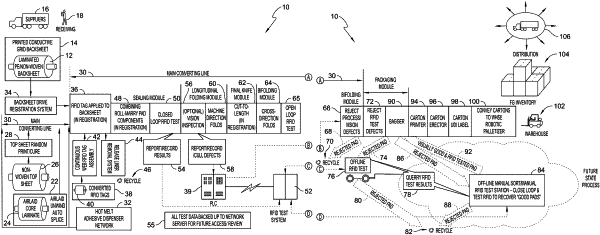| CPC A61F 13/42 (2013.01) [A61F 13/15723 (2013.01); A61F 13/15747 (2013.01); G06K 19/0722 (2013.01); A61F 2013/1591 (2013.01); A61F 2013/424 (2013.01)] | 21 Claims |

|
1. A method of manufacturing incontinence detection pads that have wireless communication capability, the method comprising
readying an RFID tag applicator to place RFID tags on backsheet material that is fed between a pair of nip rollers, the backsheet material having a series of electrode traces thereon;
operating a nip roller motor to feed the backsheet material between the pair of nip rollers and toward the RFID tag applicator;
operating the RFID tag applicator to place each RFID tag across regions of a respective electrode trace of the series of electrode traces; and
operating RFID tag test equipment to energize each RFID tag a first time and a second time using wireless emissions and receiving return signals from each RFID tag in response to the wireless emissions, wherein in response to being energized the first time by the RFID tag test equipment, each RFID tag is configured to respond by sending first data wirelessly, wherein in response to being energized the second time by the RFID tag test equipment, each RFID tag is configured to respond by sending second data wirelessly, the second data being different than the first data.
|